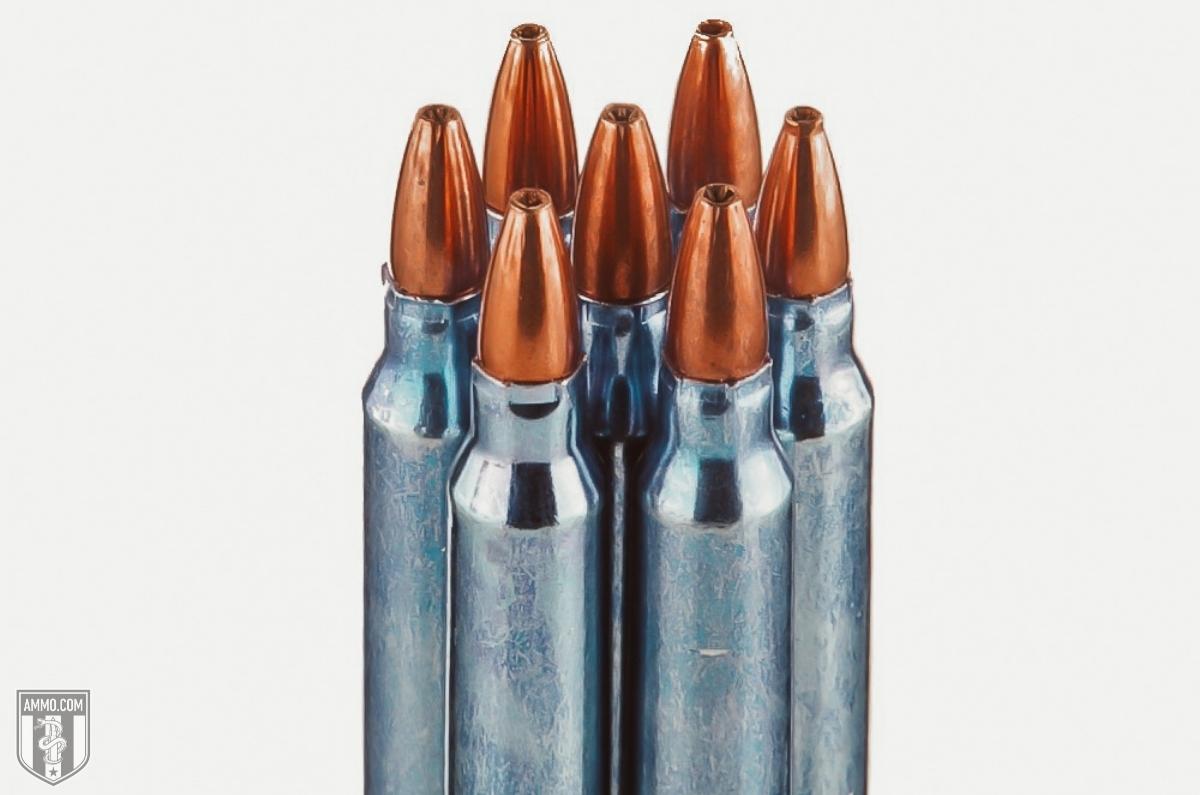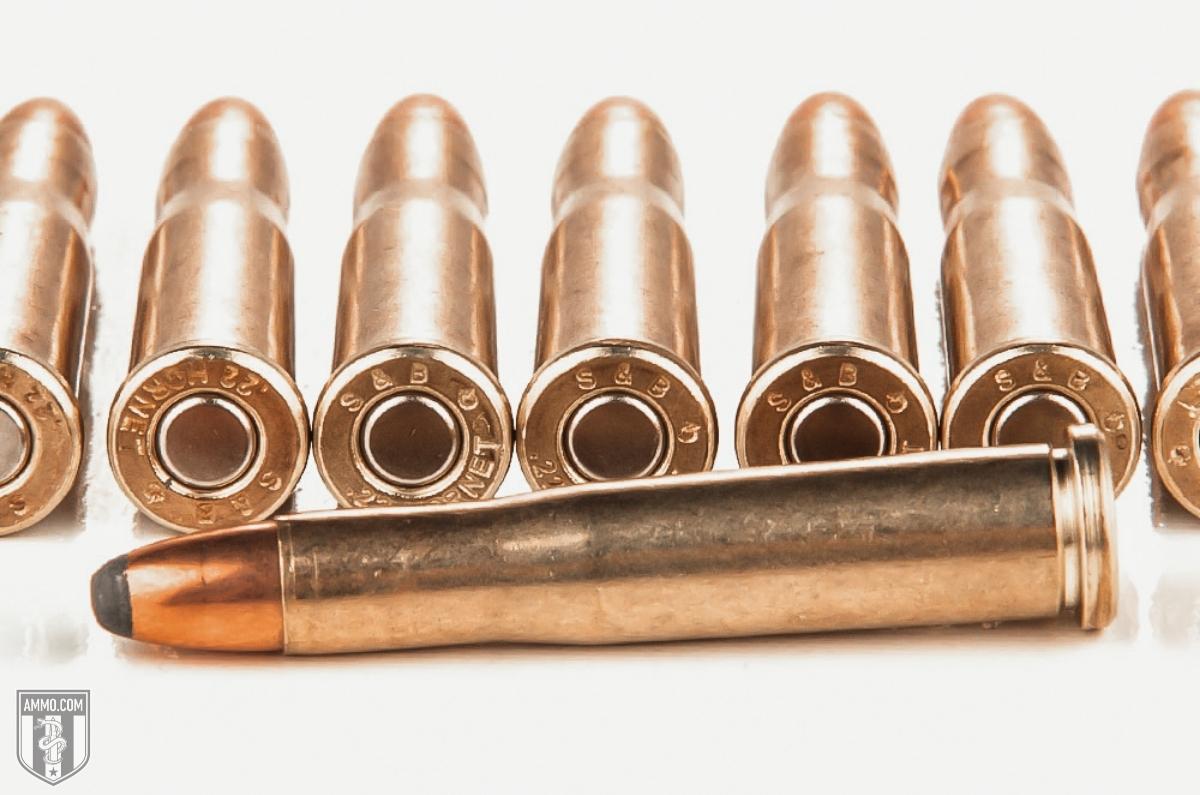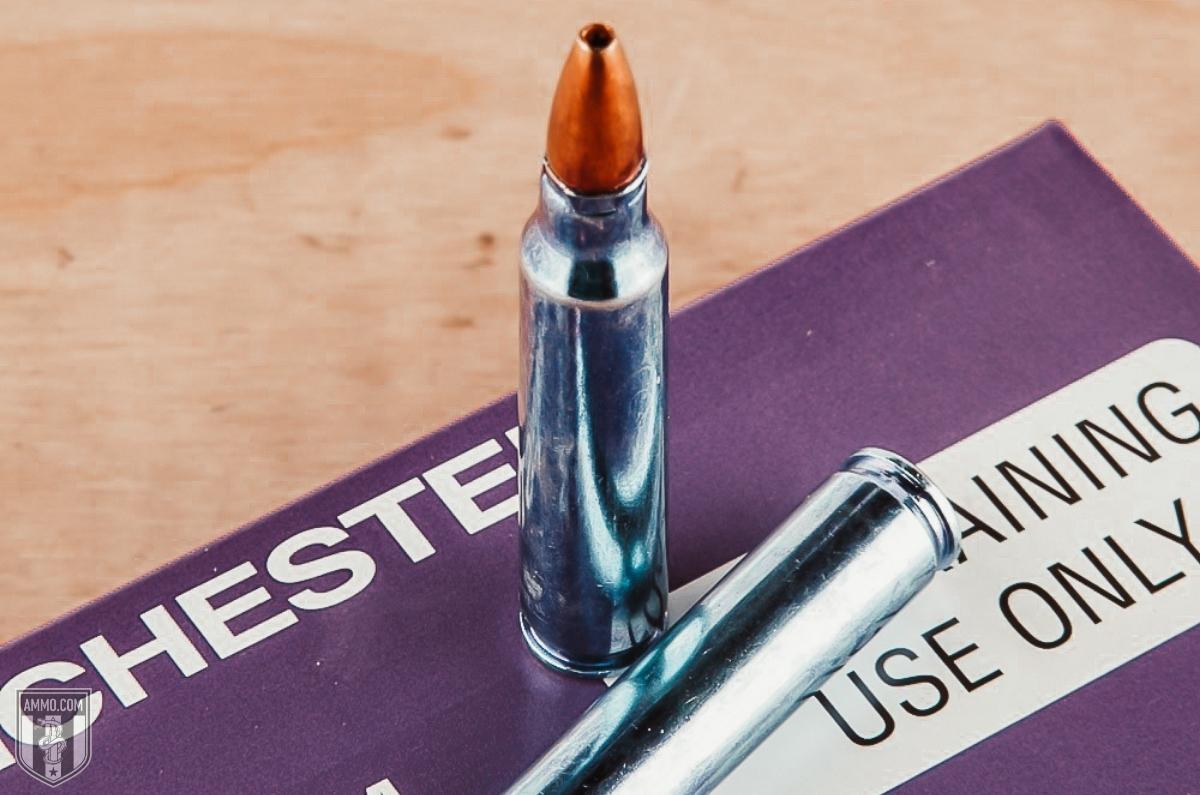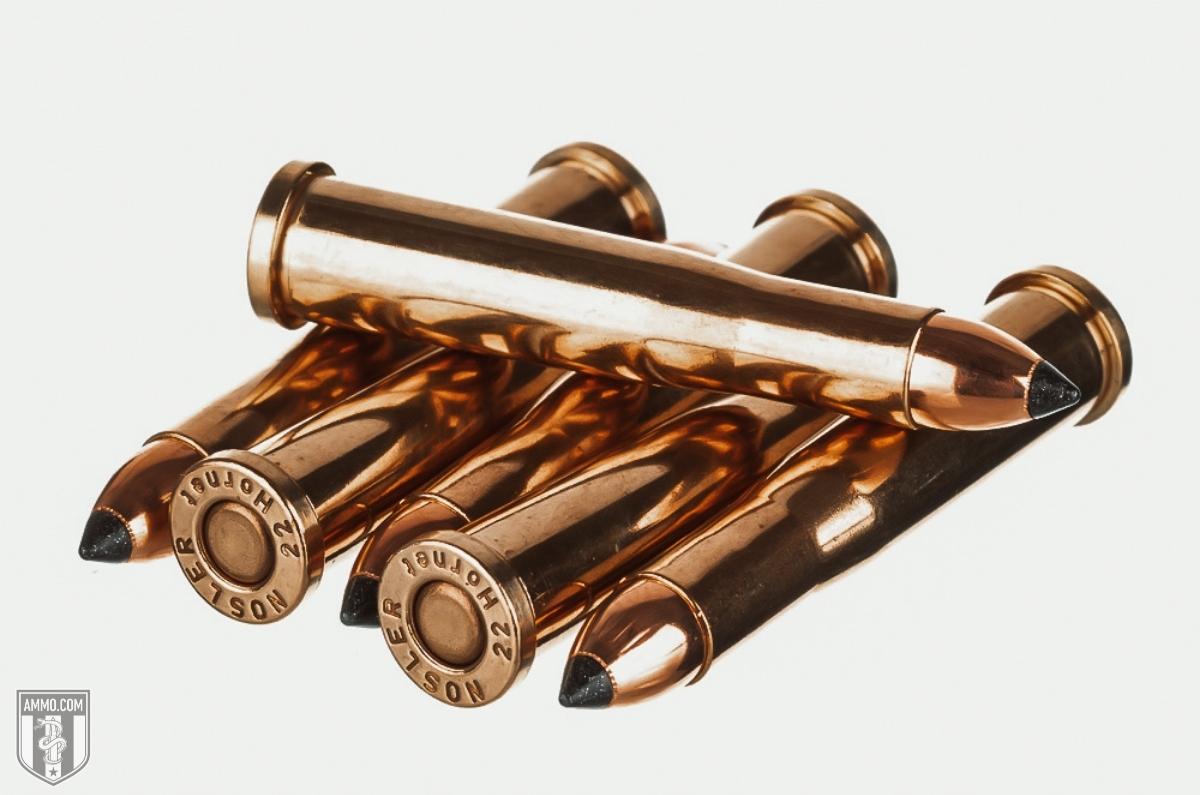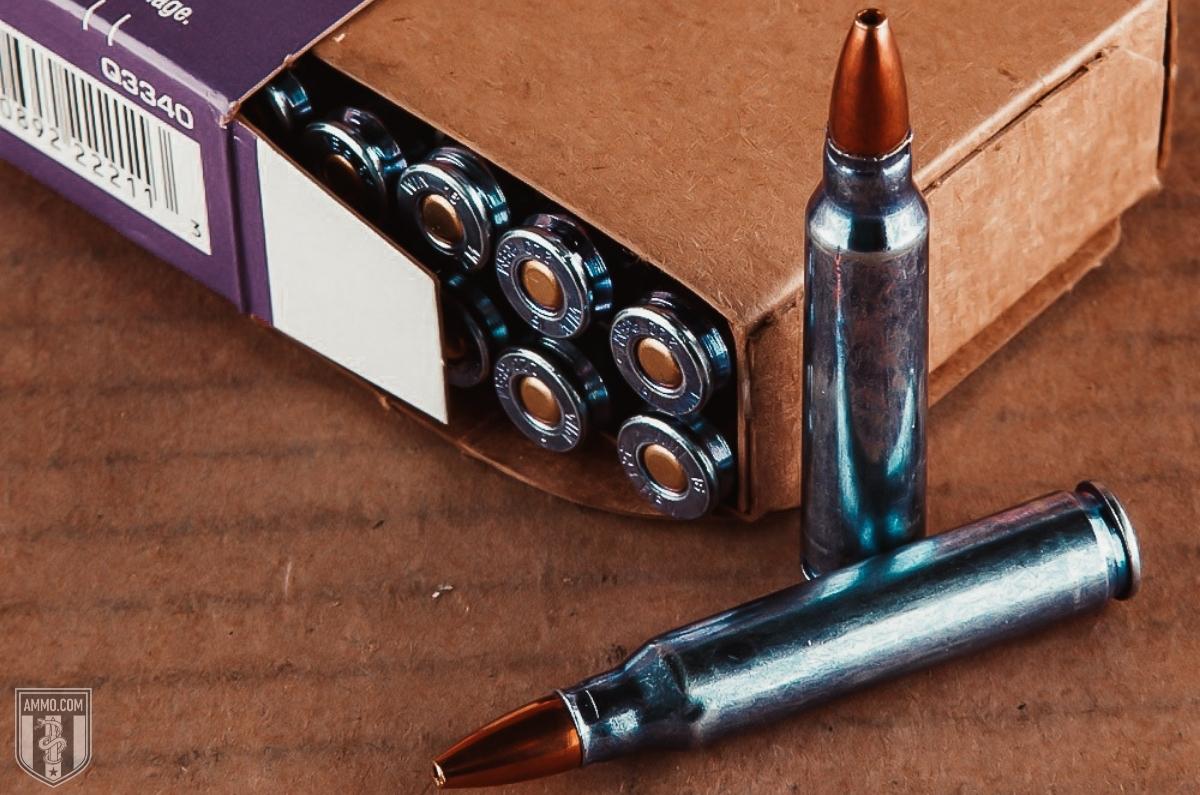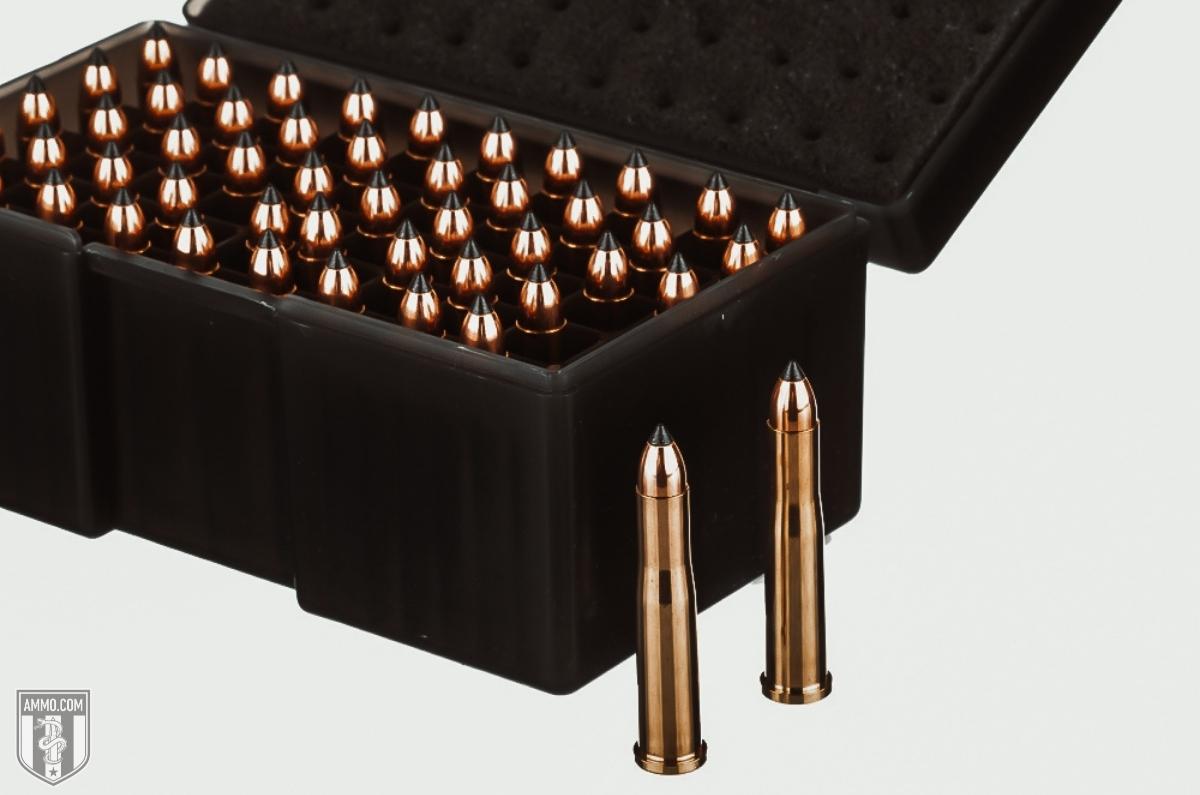22 Hornet vs 223: The Coyote’s Bane
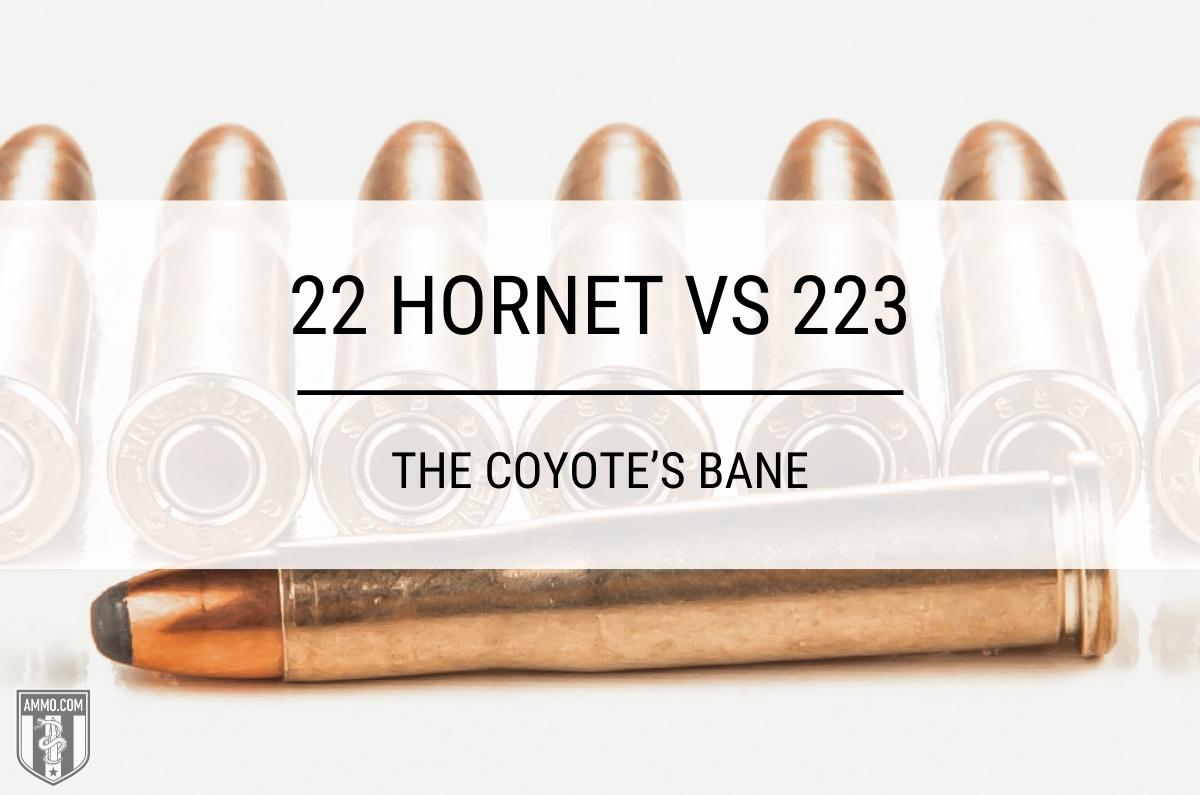
When it comes to varmint hunting, there are few rounds that can compete with the popularity and success of the 223 Remington. Since its release in 1964 and adoption by the US military, the 223 Rem has been nigh untouchable as the go-to option for plinking, long range target shooting, and varmint hunting.
However, before the 223 was even a twinkle in Remington’s eye, the 22 Hornet ruled the roost as the king of the varmint cartridges. With extremely high muzzle velocity for its time, it was not uncommon for hunters to harvest coyotes at 200 yards with iron sights thanks to the Hornet’s flat trajectory.
Although the 223 Remington outperforms the 22 Hornet in every ballistic category, the Hornet is one of those cartridges that refuses to die as it’s a perfect bridge caliber between the rimfire 22HMR and 223.
In this article, we will evaluate the 223 vs 22 Hornet to help you understand the differences between the two and give you a clearer idea of which cartridge is best for your shooting needs.
What is the difference between 22 Hornet and 223?
The difference between 22 Hornet and 223 is that the 223 Rem has higher case capacity and can shoot heavier bullets at higher muzzle velocities than the 22 Hornet.
Cartridge Specs
When evaluating centerfire rifle cartridges, it’s a good idea to analyze the cartridge specs to gain more knowledge of each.
When you put the 22 Hornet next to the 223 Rem, it’s clear that the biggest difference between these two centerfire cartridges is their size. The 223 simply towers over the tiny Hornet as the 223 has over an half inch longer overall length at 2.26” compared to 1.723” for the 22 Hornet.
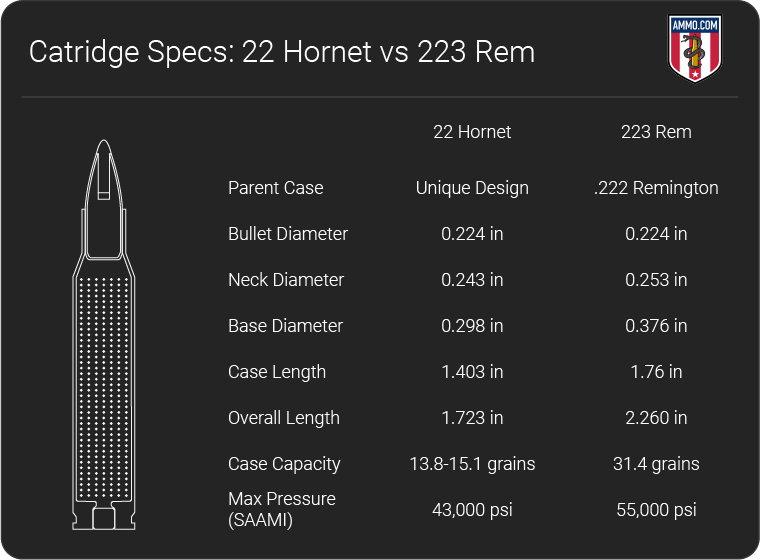
With a longer case, the 223 Rem dominates in case capacity, holding over double the amount of powder. The 223 Rem can has a case capacity of 31.4 gr while 22 Hornet brass can hold between 13.8 and 15.1 gr of powder based on the case manufacturer.
Although the 223 Remington case is considerably larger than the 22 Hornet, they both fire the same 0.224” diameter bullets. Most factory Hornet loads will be tipped with a 45-grain bullet, but Hornady has a 35 gr V-MAX bullet option that is also popular. In contrast, the 223 can be loaded with bullet weights between 35 and 77 grains with the 55 and 62 gr loads being the most popular.
One other difference that is easy to spot is that the 22 Hornet is a rimmed cartridge, designed for single shot or bolt-action rifles, while the 223 is a rimless design made for semi-automatic rifles as well as bolt-actions.
The 223 Remington can handle considerably more chamber pressure at a maximum of 55,000 PSI per SAAMI specs. On the other hand, the notoriously thin case walls of the 22 Hornet can only handle 43,000 PSI.
Although the 22 Hornet is technically a unique design, the inspiration for the Hornet came from a black powder cartridge, the 22 Winchester Centerfire (WCF). On the other hand, the 223 Rem descended from the 222 Remington, which itself served as a parent case for the .221 Fireball.
Recoil
One of the major advantages of the 22 Hornet is that it has extremely low recoil.
Recoil is an important consideration when purchasing a new rifle as a round with heavy recoil will be more difficult to control and will slow your rate of follow up shots.
Recoil is affected primarily by muzzle velocity (FPS), powder charge, bullet weight, and rifle weight.
On average, a 22 Hornet will have around 1.6 ft-lbs of free recoil compared to an average of 4 ft-lbs of free recoil for the 223 fired from a 7-pound rifle.
Both cartridges are considered low recoil, and almost all shooters would agree that the 223 has incredibly low recoil for the performance that it offers. However, it is not surprising that the 223 has higher recoil as it has over double the case capacity of the 22 Hornet.
Both cartridges are extremely easy to handle, and new shooters should not be concerned about the recoil of the 223 Rem. However, for extremely recoil sensitive shooters, the 22 Hornet is the better choice.
Muzzle Velocity, Kinetic Energy, and Trajectory
The 223 Remington simply outperforms the 22 Hornet in terms of muzzle velocity, kinetic energy, and trajectory due to its higher case capacity.
With its higher case capacity and muzzle velocity, the 223 Rem dominates the 22 Hornet in all ballistic categories.
In the chart below, we compare two different varmint loads for each rifle cartridge. For the 22 Hornet we will compare the 35 gr Hornady V-MAX and a stereotypical 45 gr soft point bullet, which is the most common Hornet load found from multiple manufacturers. For the 223 Remington we will compare the 35 gr NTX SuperFormance and the 55 gr V-MAX, both from Hornady. All rounds will have a 100 yard zero.
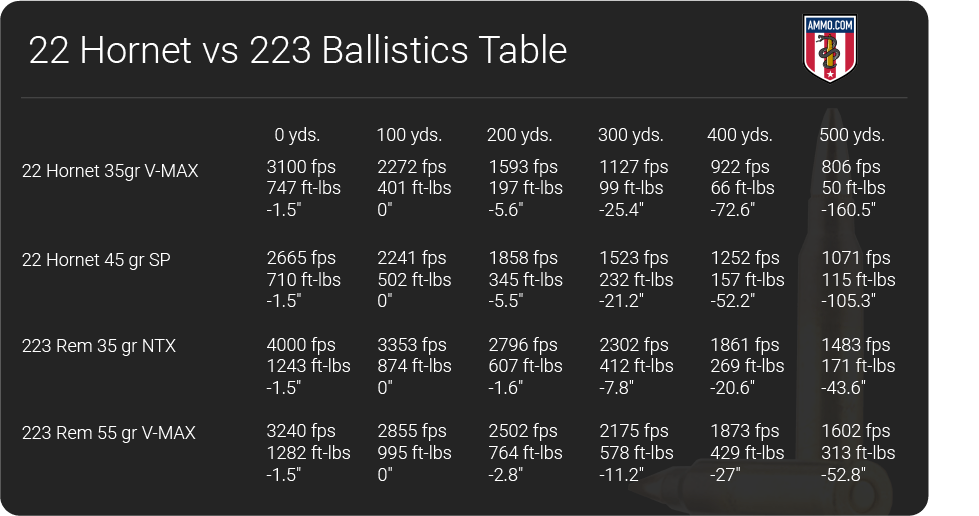
As you can see, the 223 Rem outperforms the 22 Hornet at all ranges.
In terms of muzzle velocity, the 223 and its massive case capacity simply dominates the 22 Hornet at all ranges. For example, the 55 gr V-MAX fired by the 223 has the same velocity at 200 yards as the 45 gr soft point for 22 Hornet has at the muzzle.
For kinetic energy, the 223 has approximately 500 ft-lbs more energy at the muzzle than both Hornet loads. Similar to muzzle velocity, the 55 gr V-MAX round has slightly more kinetic energy at 200 yards as both 22 Hornet loads have at the muzzle.
As the 223 bullets have a higher muzzle velocity, they will reach their target faster. This means that gravity will have less time to affect their flight path and therefore have a flatter trajectory. Many 22 Hornet fans will note that the effective range of the Hornet is around 200 yards, but even at this range the 223 has half the bullet drop of the Hornet.
In terms of effective range, the 223 can remain supersonic (above the speed of sound) well past 500 yards, while the 35 gr V-MAX Hornet load will go subsonic at 300 yards and around 450 yards for the soft point 45 grain bullet.
In terms of ballistics, the 223 is clearly the superior option.
Ballistic Coefficient and Sectional Density
The 223 Remington will typically have a higher ballistic coefficient and sectional density than the 22 Hornet.
Ballistic coefficient (BC) is a measure of how aerodynamic a bullet is and how well it will resist wind deflection. Sectional density (SD) is a way to evaluate the penetration ability of a bullet based on its external dimensions, design, and weight.
As the 223 can fire heavier bullets at higher muzzle velocities, it will typically always have a higher BC than the 22 Hornet. Even with bullets of the same weight, the 223 will have less wind drift due to its higher velocity.
The 22 Hornet has a ballistic coefficient of 0.109 and 0.202 for the 35 gr and 45 gr bullets compared in the previous section, respectively. For the 223, the 35 gr bullet has a BC of 0.177 while the 55 gr bullet has a BC of 0.255.
For sectional density, penetration is somewhat similar between the 22 vs 223. Bullets of the same weight and design will have the same sectional density, so the two 35 grain bullets have the same SD of 0.100. However, the 223 will generally have higher SD values as it can fire heavier bullets. The 223 Rem 55 gr Hornady V-MAX has a SD of 0.157 compared to 0.128 for the 45 gr soft point for the 22 Hornet.
Hunting
Both the 22 Hornet and 223 Remington are excellent varmint hunting options. However, the 223 affords a hunter longer effective range and a flatter trajectory.
For thin skinned varmints, both of these rifle cartridges are more than powerful enough to get the job done. From rabbits to raccoons to coyotes, the Hornet and 223 pack more than enough punch to take on these critters.
Magnified optics were not very popular in the 1930’s when the Hornet was introduced, therefore hunters were typically limited to their own marksmanship ability and the limits of their vision. That being said, it was not uncommon for hunters of the day to take down varmints with their single shot or bolt-action Hornet rifle at 200 yards with iron sights.
The 22 Hornet was so popular in the pre-WWII ear that the US Army Air Corps (which later became the US Air Force) issued their airmen with a survival rifle chambered in 22 Hornet. They were also issued soft point ammunition with the stipulation that it only be used on small game for food, as the use of expanding bullets was forbidden by the Hague Convention.
Prior to WWII, the 22 Hornet was one of the most popular varmint cartridges on the market. Even though faster cartridges like the 220 Swift, 218 Bee, and 22-250 were available in the late 1930’s, many hunters preferred the incredibly low recoil and accuracy that the 22 Hornet provided. Furthermore, the 22 Hornet offered hunters more power than the 22 Long Rifle, 22WMR, and the newer 17 HMR.
After WWII, the 22 Hornet’s popularity started to wane as newer hotshot rounds like the 222 and 223 Remington began to encroach on the Hornet’s market share of varmint hunting.
When it comes to whitetail, the 22 Hornet lacks the kinetic energy needed for ethical deer hunting. The efficacy of the 223 Rem on deer is a hotly debated topic on hunting forums and around campfires. Expanding heavier bullets like the 75gr Swift Scirocco II offer better terminal performance on medium sized game like hogs and can be used for deer hunting in some states.
Neither cartridge is an ideal choice for deer, however the 223 is the better option. In terms of varmints, under 200 yards both cartridges are more than capable but for longer range shots over 200 yards the 223 is the better choice.
Ammo and Rifle Cost/Availability
The 223 Remington is one of the most popular rounds in North America, therefore ammo and rifle availability is high while cost is relatively low.
Although the 22 Hornet was released in 1930, it wasn’t until 1933 that rifles were specifically manufactured for it. At first, older rifles like the Springfield 1922 or the single shot Martini Cadet had to be retrofitted to fire the new wildcat cartridge.
This somewhat handicapped the 22 Hornet’s acceptance in the mainstream shooting world, and it wasn’t until three years later that production of the new Winchester Model 54 bolt-action rifle brought attention to the new cartridge. After this, other companies started producing rifles chambered in the new Hornet round and it began to see considerably more mainstream use.
Older Hornet rifles had a 1:16 twist rate, which has a hard time stabilizing a bullet heavier than 45 gr. However, modern Hornet rifles like the Savage 25 Varminter and Ruger 77/22 have a faster twist rate of 1:14 which can stabilize heavier bullets for those hunters who like to handload.
Although there are a lot of old and new 22 Hornet rifles on the market, it cannot compete with the widespread popularity of the 223 Remington.
While the Hornet is restricted to primarily single shot or bolt-action rifles, the 223 enjoys the flexibility of also being chambered in the most popular semi-automatic firearm on the planet, the AR-15. The 22 Hornet is also available in several handguns from Taurus as well as the Thompson/Center Contender.
As far as ammo cost is concerned, the 223 cannot be beat thanks to its widespread popularity.
Buying in bulk is always smart, make sure to check out our stock of 223 bulk ammo.
Factory ammo for the 223 is common and easy to find, with cheap FMJ ammo running around $0.60/round. On the other hand, 22 Hornet ammo runs around $1.30/round for most factory loads.
Reloading
If you like to handload your own ammo, both cartridges offer you a lot of options for customization.
The 223 has a plethora of options available to it, with cheap once-fired brass being extremely plentiful and easy to find. Bullets are also extremely easy to source and allows for a wide variety of reloading options.
The 22 Hornet was somewhat revitalized by the introduction of Hodgdon Lil’Gun and H110 powders, which performed extremely well with the older cartridge. This new powder allowed reloaders to experiment with the 22 Hornet and load heavier bullets in it that worked well with the faster twist rate of new bolt-action rifles and handguns.
Although some shooters might claim the 22 Hornet is perfect just the way it is, the K-Hornet is one wildcat cartridge developed to improve upon the original design. Developed by Lysle Kilbourn in 1940, a K Hornet cartridge has sharper shoulders which improves case capacity.
Producing K-Hornet brass is extremely simple, as all one must do is fire form original 22 Hornet brass in a K Hornet chamber.
Although performance is dependent upon barrel length, some handloaders report achieving velocities close to 3,200 fps firing a 35 gr Hornady V-MAX out of their K-Hornet rifles.
One important thing to note when reloading for a 22 Hornet is its thin case walls. With multiple handloads, the brass can begin to stretch and weaken. Make sure to discard any Hornet brass that is showing signs of case-head separation.
Final Shots: 223 vs 22 Hornet
When it comes to ballistics, the 223 Remington clearly dominates over the 22 Hornet in all categories excluding recoil. These advantages, as well as military adoption, led to the widespread adoption of the 223 Rem over the 22 Hornet.
Although the 223 technically does have higher recoil, most every shooter will tell you that the felt recoil of the 223 is extremely light and easily manageable when compared to something bigger like a 30-06 Springfield.
But does this mean that the 22 Hornet is an obsolete cartridge? Not in the slightest.
The Hornet has something special that cannot be quantified: nostalgia.
There’s something special about popping some Yotes your grandfather’s or uncle’s old 22 Hornet rifle using only iron sights. Furthermore, the 22 Hornet offers more kinetic energy and muzzle velocity than the rimfire 22 WMR, which is also a potent coyote cartridge.
Most shooters will opt for the 223 Remington, as its ammo availability and compatibility with the AR-15 or other semi-auto rifles makes it an awesome choice for long range target shooting, plinking, hogs, or any other varmint that need to be cleared off your property.
But don’t dismiss the little 22 Hornet, as it is an extremely potent cartridge inside 200 yards with barely any recoil. People who shoot it fall in love with it, so if you get the chance to squeeze off a few rounds on a buddy’s rifle, I’d highly recommend you give it a try to find out what the love fest is all about.
No matter which cartridge you choose, make sure you stock up on ammunition here at Ammo.com and I’ll see you on the range!
Ammo Comparisons
- .308 vs 5.56
- 6.5 Creedmoor vs .308
- .300 Blackout vs .308
- .300 Win Mag vs .308
- .243 vs .308
- .308 vs .30-06
- 7mm-08 vs .308
- .270 vs .308
- 7.62x39 vs .308
- .223 vs .308
- .338 Lapua vs .308
- .380 ACP vs 9mm
- .223 vs 5.56
- .300 Blackout vs 5.56
- 9mm vs 45 ACP
- 9mm vs 40 S&W
- .357 SIG vs 9mm
- 10mm vs 9mm
- 9mm vs 9mm Luger
- .243 vs .270
- .300 Win Mag vs .30-06
- .270 vs .30-06
- .40 vs .45
- 38 Special vs 357
- 9mm vs 40 vs 45
- 5.56 vs 7.62x39
- 338 Lapua vs .30-06
- .30-30 vs .30-06
- 300 PRC vs 338 Lapua
- .30-06 vs 7mm
- 300 Win Mag vs 338 Lapua
- 300 PRC vs 300 Win Mag
- 300 WSM vs 300 Win Mag
- 338 Win Mag vs 338 Lapua
- 12 Gauge vs 20 Gauge
- 10mm vs 357 Mag
- .30-30 vs 7.62x39
- 224 Valkyrie vs 22-250
- 17 HMR vs 22 Mag
- 7.62x39 vs .300 Blackout
- 45 ACP vs 45 Auto
- 45-70 vs 30-30
- 300 Blackout vs 223
- 357 Magnum vs 9mm
- 350 Legend vs 300 Blackout
- 224 Valkyrie vs 223
- 45 ACP vs 38 Super
- 6.5 Grendel vs .308
- 17 HMR vs 22 LR
- 10 Gauge vs 12 Gauge
- 22-250 vs 223
- 45 Colt vs 45 ACP
- 350 Legend vs 30-30
- 5.7x28 vs 223
- 5.7 vs 9mm
- 5.56 vs 5.7
- 22 vs 9mm
- Buckshot vs Birdshot
- 450 Bushmaster vs 308
- 450 Bushmaster vs 223
- Buckshot vs Slug
- 6.5 Grendel vs 5.56 vs 223
- 6mm ARC vs 6.5 Grendel
- 44 vs 45
- 458 SOCOM vs 5.56
- 357 vs 44
- 32 ACP vs 380
- 300 Win Mag vs 338 Win Mag vs 338 Lapua Mag
- 450 Bushmaster vs 458 SOCOM vs 50 Beowulf
- 6mm Creedmoor vs 6.5 Creedmoor
- TMJ vs FMJ
- 44 Special Vs 44 Magnum
- 45 90 vs 45 70
- 6.8 Western vs 6.8 SPC
- 50 Beowulf vs 50 BMG
- 26 Nosler vs 6.5 PRC
- 28 Gauge vs 410
- 6.8 SPC vs 5.56
- 6.8 SPC vs 6.5 Grendel
- 6.8 Western vs 7mm Rem Mag vs .28 Nosler
- 6.8 Western vs 6.5 Creedmoor
- 22 Hornet vs 223
- 6.8 Western vs 6.5 PRC
- .410 vs 12 Gauge
- .410 vs 20 Gauge
- 22 LR vs 22 Mag
- 6mm ARC vs 243
- 7mm-08 vs 270
- 243 vs 6.5 Creedmoor
- Nickel vs Brass Casing
- 204 Ruger vs 223
- 50 Beowulf vs 5.56
- 260 Remington vs 6.5 Creedmoor
- 6mm Remington vs 243
- 28 Nosler vs 300 PRC
- 50 Beowulf vs 50 AE
- 22 Nosler vs 22-250
- 450 Marlin vs 45-70
- 300 Win Mag vs 300 Norma
- 458 SOCOM vs 300 Blackout
- 38-55 vs 45-70
- 22 Hornet vs 22 LR
- 300 Norma vs 338 Lapua
- 338 Lapua vs 50 BMG
- 28 Nosler vs 300 Win Mag
- 28 Nosler vs 6.5 Creedmoor
- 204 vs 22-250
- 458 SOCOM vs 45 70
- 44 40 vs 45 70
- 6.8 SPC vs 6.5 Creedmoor
- 450 Bushmaster vs 30-06
- 7mm Rem Mag vs 300 Win Mag
- 30 Carbine vs 223
- 25-06 vs 30-06
- 26 Nosler vs 28 Nosler
- 16ga vs 12ga
- 30 06 vs 7.62 x54R
- 9mm Makarov vs 9mm Luger
- 350 Legend vs 223
- 30 Carbine vs 5.56
- 6.5x55 vs 6.5 Creedmoor
- 6.5 Creedmoor vs 270 vs 25-06
- M193 vs M855
- 450 Bushmaster vs 458 SOCOM
- 6.5 Grendel vs 6.5 Creedmoor
- 350 Legend vs 5.56
- .277 Fury vs 6.8 SPC
- 277 Fury vs 300 Win Mag
- 10mm vs .45 ACP
- 277 Fury vs 223
- 6.8 SPC vs 300 Blackout
- 6.5 PRC vs 6.5 Creedmoor
- 277 Fury vs 308
- 277 Fury vs 6.5 Creedmoor
- 350 Legend vs 450 Bushmaster
- 277 Fury Vs 5.56 NATO
- 10mm vs 40S&W
- 32 ACP vs 9mm
- 32 Special vs 9mm
- 8.6 Blackout vs 300 Blackout
- 30 Super Carry vs. 9mm
- 5.56 vs 9mm
- .50 Action Express vs 9mm
- 7.62x25 vs. 9mm
- 10mm vs 44 Magnum
- 300 Blackout vs 300 Win Mag
- 6.5 Grendel vs 300 Blackout
- 460 Rowland vs 10mm
- 300 RUM vs 300 PRC
- 300 Norma vs 300 PRC
- 45 GAP vs 45 ACP
- 7mm PRC vs 300 Win Mag
- 300 PRC vs 6.5 Creedmoor
- 300 PRC vs 308
- 357 SIG vs 357 Mag
- 7.62x39 vs 7.62x51
- 243 Win vs 223 Rem
- 30 Nosler vs 300 PRC
- 6.5 Creedmoor vs. 30-06 Springfield
- 450 S&W vs. 44 Magnum
- 6.5 Creedmoor vs. 300 Win Mag
- 454 Cassull vs. 45-70 Govt
- 454 Cassull vs. 44 Mag
- 7.62x54r vs. 308 Winchester
- 22 ARC vs. 223 Rem
- Subsonic vs. Supersonic Ammo
